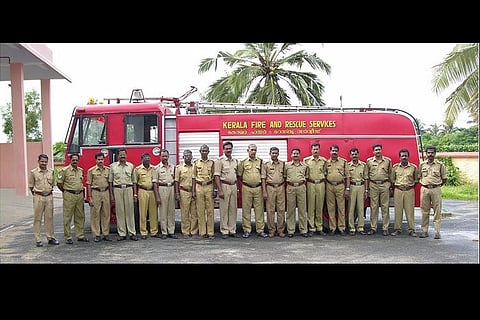

A 40-something man climbs onto a 30-ft-tall tree with a bag hanging from his shoulder. At first, everybody ignores him thinking he’s up there to hang a banner advertising some product or the other. When he sees that the passersby aren’t bothering about the words on his banner, the man stands on one of the trees branches and threatens to kill himself.
This is a scene from Kerala’s Thrissur district on Friday, when a man threatened to throw himself off a tree in the compound of the District Collectorate if the Chief Minister did not resign. The man claimed he had taken this drastic decision since “law and order in the state had crumbled.”
Even as a team of 12 Fire and Rescue personnel strategised on how to successfully bring him down, the man poured petrol over his body. Recognising the urgency of the threat, the team doused him with water from a fire truck so he couldn’t set himself ablaze. Thankfully, the force of the water also made the man lose his perch and land safely in a net the rescue personnel had laid around the tree.
In all, the entire rescue took over an hour. As the crowd cheered the team for its successful rescue, Thrissur Fire and Rescue Station Officer AL Lassar breathed a sigh of relief.

Unlike rescue operations at disaster sites, the 50-year-old officer says, rescuing a person who is bent on taking their life is a much more challenging task in many ways.
“Patience is the key word here. Our aim is to be careful not to provoke the person, but to amicably make the person get down on their own. Most often, they climb onto a tall structure such as a tree, water tank or a building,” Lassar says.
What distinguishes such cases from other cases of suicide or attempted suicide, says Lassar, is that people take this drastic step not to end their lives but to bring an urgency to whatever grievance they have.
“In most cases, more than their own personal problems, they have a demand to be fulfilled by the government. It also involves the element of seeking publicity, in the belief that their problems will be resolved through media attention,” the officer says.
But this doesn’t mean that these people want to be rescued, he adds, and that’s what makes their jobs so difficult.
Counselling the person in order to buy time for the rescue team is the most crucial task rescuers face in such scenarios. When Lassar reached the spot on Friday, his main goal was to divert the attention of the man on the tree till the fire engine arrived. This is often the case because the rescue team reaches the spot initially, with the fire truck called in afterwards.
"It was only after a few minutes that he took out the petrol bottle from his bag. We had to immediately get the fire engine then,” explains Lassar.
“We need time. Not that we are given special training in counselling, but that is part of such operations,” he explains.
How to achieve this varies depending on personnel and the situation. One strategy, says Lassar, is convincing the person their demands will be met. “In this case, the man said that he will only get down from the tree once the CM and minister AC Moideen arrive. I had to act like I was speaking to the minister over phone to convince him. I said the minister was on his way so that he would not do anything immediately," Lassar explains.
Shihabuddhin, who has been a fire and rescue personnel for the past 17 years, says that another strategy is to tap into the fear of dying in people.
"Though they threaten to kill themselves before the public, there is always the fear of dying. We need to address that fear and convince the person to not do so," he says.
Whatever strategy they employ, says Shihabuddin, it can sometimes take hours, with everyone balanced on that knife edge where one move could result in a death. "Once I had to convince this young man who had switched on the gas cylinder at his house and had a match stick ready in his hand. He wanted his wife who had left him to come back,” he narrates.
“After hours of talking to him, he wasn't ready to drop the matchstick. I kept telling him that I spoke to his wife over phone and that she is on her way. But he wouldn't listen. We had kept water hoses ready and the moment he struck the match, we opened up the hose," he explains.
Biju, a rescue officer at Thiruvananthapuram's Chenkalchoola fire station, explains that such rescues are long and exhausting processes because they can’t use force against a person who is in a fragile state.
Narrating one rescue his team of 10 carried out, he says, "A young man had climbed on to a tree outside the Secretariat demanding a job. We arrived at the scene in the afternoon. Our team stayed at the spot the whole night talking to him as we couldn’t have used force to get him down. It was only the next morning that he agreed to a compromise," Biju says.
At the same time, rescue officers put themselves at risk because those they are rescuing often use force to keep themselves from being saved. Lassar gives the example of a mentally-challeneged man who had climbed onto a tower at a hospital in Guruvayoor some years ago. "He would kick us so that we would fall off while trying to climb up the ladder. But we rescued him eventually," the officer says.
As exhausting, challenging and resource-consuming as such operations are, rescue officers are just glad that such cases are not a more regular occurrence. On average, they say, they handle about four or five such cases every year in each jurisdiction.
(Edited by Rakesh Mehar)